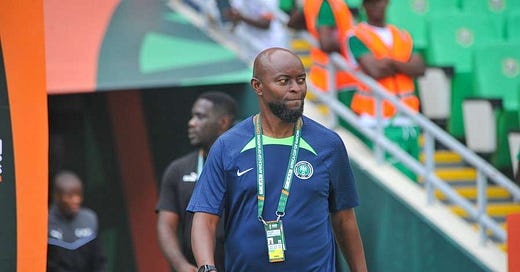In almost every context, a Nigeria win over Ghana is a big deal; irrespective of a number of caveats, Friday’s was no different.
The Black Stars were reduced to 10 men early in the second half, an odd decision given it was a friendly (in as much as any meeting between these two can be termed as such), and both sides were helmed by different coaches than oversaw their most recent previous outings. Neither team was quite full strength either, a number of key players sidelined due to injury, and the location – Marrakech is a lovely city, but boasts no significant population from either nation – did little for the atmosphere on matchday.
In spite of these, somehow, an enjoyable contest erupted. While Otto Addo’s Ghana more than played their part despite the red card, Finidi George’s approach to the proceedings was more interesting on account of the fact that, unlike his counterpart, this was his first go at leading the senior men’s national team.
There was also a bit of nuance. Whereas the Black Stars’ failure at the Africa Cup of Nations (AFCON) essentially afforded Addo a clean slate to work with, Finidi, who was a part of the technical crew under previous coach Jose Peseiro, was beholden to the legacy of the Super Eagles’ second-place finish in Cote d’Ivoire.
To that end, he stuck with the basis of the Portuguese’s latter structure: a back five with a double pivot mopping up in front.
That is not to say that he could not have ripped up the blueprint altogether. However, what purpose would it have served, given Finidi’s current situation? The Enyimba coach is in the role solely as a consequence of the cosmic incompetence and endemic tardiness of the Nigeria Football Federation (NFF), and while he is one of those who took advantage of the open application process to chuck his hat into the ring for consideration on a permanent basis, there is a good chance this international window is the only time he will ever take the big chair in the Super Eagles’ dugout.
What’s more, in keeping with the modus operandi of the country’s football administration, he was placed in the no-win situation of having to make bricks without straw. With no assistants to take training sessions with save for the goalkeeper coach, there was even less wisdom in reinventing the wheel.
There were, nevertheless, unmistakable points of departure, most notable of which was a clear intent to put pressure on the opponent out of possession. Contrary to what many remember, Peseiro’s side did press, but that was within a more situational scheme that relied on certain triggers and that seemed to engage specific players (Victor Osimhen, Frank Onyeka and Ola Aina especially). Here, the team as a whole went, mostly in a man-oriented scheme, and there was more of an eagerness to both crowd the ball carrier and close down immediate passing options.
There were extended periods of success with this strategy, especially in the first period, with the clear upside being that Nigeria did not spend the majority of the half hunkering down in their own defensive third. As with most man-oriented pressing structures, however, it was susceptible to players capable of playing on the turn, as well as to dribblers. The key to defeating man-marking is to win your immediate duel, and Ghana did this over and over in the second half, using Nigeria’s eagerness to play on the front foot against them.
The second key difference was in the use of Kelechi Iheanacho in defensive transition. Peseiro collapsed his team into a 5-4-1 mid-to-deep block; while this offered double protection in wide areas as well as half-space coverage, it had the effect of isolating Osimhen when possession was turned over. As a result, the Napoli man’s role was overly focused on winning duels, offering runs into the channels and holding the play up for the rest of the team to arrive.
Finidi, clearly, saw this as a concern, and addressed it with the use of Iheanacho in a line with starting centre-forward on the day Cyriel Dessers. “...in the AFCON, it was only Osimhen and we felt he was doing so much running so I wanted some other player to do that,” he explained afterward. “At least that pair (sic) will help.”
This made Nigeria even more dangerous in transition, and Dessers was all the more effective for it, scoring a penalty and having by far his best performance for Nigeria. However, defending in a 5-3-2 meant weaker coverage in wide areas, and this exposed the Super Eagles in a number of scenarios, especially after the break. Tactics are about trade-offs, essentially: there is no structure without a weakness in some zone. The good news, however, is that you choose your handicap, and that choice is perhaps the most telling indicator of your ideology as a coach.
What Finidi showed is that, unlike his predecessor, he will gladly take one to give one.
That philosophy does have its drawbacks, but most of what did go wrong on the day was clearly a consequence of time—specifically the lack thereof: timing of pressing actions, switching markers, and socio-positional details out of possession. To say anything definitive about his capacity for the job on a full-time basis would be premature, but there is something to be said for the lucidity of his thinking in extenuating circumstances.
Knowing what to tweak and what to leave well enough alone betrayed a pragmatism and humility that cannot have hurt his chances.




This is incredibly well written
You're a gem. Content, structure and delivery has made this a masterpiece. Thank you.